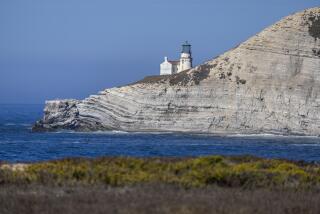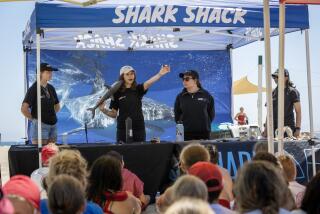Sobering Land-Sea Connection Sinks In
- Share via
Fifth-grader Manuel Belteton never realized that a driveway carwash could hurt an ocean several miles away.
The San Juan Capistrano boy’s watershed moment -- in addition to learning, for example, what a watershed is -- came Monday during a field trip to the Ocean Institute in Dana Point.
During his first boat trip, where he examined samples of harbor water and seafloor mud, Manuel studied how humans affect the environment and promised to minimize how much he and his family pollute the ocean.
“I didn’t know such little things could do so much damage,” Manuel said. “I need to do more to protect the ocean so the fish are safe and I can swim in clean water.”
Manuel came with 18 Kinoshita Elementary School classmates to the center as part of a weeklong program to teach Orange County students how their actions affect coastal health.
They also learned about protecting watersheds, the regions that drain into a lakes rivers or the ocean. Contaminants that wash into gutters and storm drains eventually reach the sea, where they can threaten swimmers and aquatic life.
Called “One Tier Back” -- because the chosen 20 schools are all a few miles from the ocean -- the program continues through winter. The 700 participating students will conduct their own research on local watersheds and present their findings at a conference in January to local officials.
“The further you are from the ocean, the harder it is to convince people that their actions affect water quality,” said Harry Helling, vice president of research and education for the institute.
The nonprofit Ocean Institute, which reopened last year after a $16.5-million renovation, is a waterfront education center aimed at providing detailed lessons on the ocean and coastal environment for tens of thousands of schoolchildren each year. City and state grants, and gifts from local philanthropists, keep the center going, and the Surf Industry Manufacturers Assn. is sponsoring the watershed program.
Teaching children to stop polluting is the key to permanently keeping the ocean clean, said Orange County coastal officials, who will lead half-hour seminars about watersheds for this week’s visitors.
“People do what they grow up doing,” said county watershed planner Marilyn Thoms. “If you don’t start them this young, it just won’t happen.”
On the Kinoshita group’s two-hour trip out of Dana Point Harbor, the children conducted tests on water and mud drawn from the ocean, filtering out the objects contained in them.
The students wrinkled their noses at the harbor mouth’s gritty, lifeless dirt and screamed in delight at the creatures pulled from farther out to sea, including pink brittle stars, clams and a mustache worm.
For many of the students in the watershed program, the experience marks their first direct contact with the ocean. About half of the Kinoshita students had never been on a boat before and, aside from having a little nausea, they were delighted with their experience.
Manuel and the other boys barked happily at the seven seals and sea lions they saw dozing on a green buoy, and two girls giggled when one of the floppy brown mammals sneezed.
Seeing how many animals live in the ocean drove home to 10-year-old Malaika Hasugulyang how important it is to keep the water clean.
“I always thought we lived too far from the ocean to make much difference in what happened there,” she said. Ticking off what she’d learned from the day’s activities, she said, “No more oil changes in the driveway, no more carwashes, and always clean up cat poop.”
More to Read
Sign up for Essential California
The most important California stories and recommendations in your inbox every morning.
You may occasionally receive promotional content from the Los Angeles Times.













